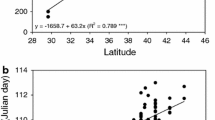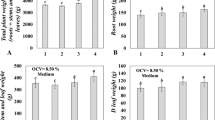Abstract
The quality of transgenic fruits was studied only for apple, plum and citrus. We first evaluated the transgenic fruit characteristics of pear, which is one of the most consumed fruit crops. The size, shape and biochemical composition of fruits from field-grown pear trees with marker genes were analyzed for 5 years. Soluble solids, vitamin C, and phenolic compounds varied significantly between transgenic lines, but these deviations were inconsistent. Arbutin content and sugar:acidity ratio were the most stable parameters. One transgenic line showed a stable increase in fruit weight (by 12.2–21.2%). The extremely dry and hot season increased the total phenolics (2.6–3.6 times) and tannin (3.2–3.6 times) levels, but not flavonoids. The harvest year had a stronger effect on analyzed fruit parameters than the genotype. Our study found no unintended effects of genetic transformation on pear fruit quality and confirms the importance of long-term field tests for perennial transgenic plants.



Similar content being viewed by others
Data Availability
Data available on reasonable request.
References
Borejsza-Wysocka E, Norelli JL, Aldwinckle HS, Malnoy M (2010) Stable expression and phenotypic impact of attacinE transgene in orchard grown apple trees over a 12 years period. BMC Biotechnol 10:41. https://doi.org/10.1186/1472-6750-10-41
Cellini F, Chesson A, Colquhoun I, Constable A, Davies HV, Engel K-H, Gatehouse AMR, Karenlampi S, Kok EJ, Leguay J-J, Lehesranta S, Noteborn HPJM, Pedersen AJ, Smith M (2004) Unintended effects and their detection in genetically modified crops. Food Chem Toxicol 42:1089–1125. https://doi.org/10.1016/j.fct.2004.02.003
Baranski R, Klimek-Chodacka M, Lukasiewicz A (2019) Approved genetically modified (GM) horticultural plants: a 25-year perspective. Folia Hortic 31:3–49. https://doi.org/10.2478/fhort-2019-0001
Kolniak-Ostek J (2016) Chemical composition and antioxidant capacity of different anatomical parts of pear (Pyrus communis L). Food Chem 203:491–497. https://doi.org/10.1016/j.foodchem.2016.02.103.
Hong SY, Lansky E, Kang SS, Yang M (2021) A review of pears (Pyrus spp), ancient functional food for modern times. BMC Complement Med Ther 21:219. https://doi.org/10.1186/s12906-021-03392-1
Đurić G, Žabić M, Rodić M, Stanivuković S, Bosančić B, Pašalić B (2015) Biochemical and pomological assessment of European pear accessions from Bosnia and Herzegovina. Hortic Sci 42:176–184. https://doi.org/10.17221/53/2015-HORTSCI
Dolgov SV, Lebedev VG, Firsov AP (2011) Pear fruit taste modification by thaumatin II gene expression. Acta Hortic 909:67–73. https://doi.org/10.17660/ActaHortic.2011.909.5
Rodríguez A, Peris JE, Redondo A, Shimada T, Costell E, Carbonell I, Rojas C, Peña L (2017) Impact of D-limonene synthase up- or down-regulation on sweet orange fruit and juice odor perception. Food Chem 217:139–150. https://doi.org/10.1016/j.foodchem.2016.080.76
Li J, Zhang C, Liu H, Liu J, Jiao Z (2020) Profiles of sugar and organic acid of fruit juices: a comparative study and implication for authentication. J Food Qual: 7236534. https://doi.org/10.1155/2020/7236534
Li X, Zhang JY, Gao WY, Wang Y, Wang HY, Cao JG, Huang LQ (2012) Chemical composition and anti-inflammatory and antioxidant activities of eight pear cultivars. J Agric Food Chem 60:8738–8744. https://doi.org/10.1021/jf303235h
Rudrapal M, Khairnar SJ, Khan J, Dukhyil AB, Ansari MA, Alomary MN, Alshabrmi FM, Palai S, Deb PK, Devi R (2022) Dietary polyphenols and their role in oxidative stress-induced human diseases: insights into protective effects, antioxidant potentials and mechanism(s) of action. Front Pharmacol 13:806470. https://doi.org/10.3389/fphar.2022.806470
Crozier A, Jaganath IB, Clifford MN (2009) Dietary phenolics: chemistry, bioavailability and effects on health. Nat Prod Rep 26:1001–1043. https://doi.org/10.1039/b802662a
Hudina M, Stampar F, Orazem P, Petkovsek M, Veberic R (2012) Phenolic compounds profile, carbohydrates and external fruit quality of the ‘Concorde’ pear (Pyrus communis L) after bagging. Can J Plant Sci 92:67–75. https://doi.org/10.4141/CJPS2011-095
Ferreira SS, Silva P, Silva AM, Nunes FM (2020) Effect of harvesting year and elderberry cultivar on the chemical composition and potential bioactivity: a three-year study. Food Chem 302:125366. https://doi.org/10.1016/j.foodchem.2019.125366
Lebedev VG, Dolgov SV (2000) The effect of selective agents and a plant intron on transformation efficiency and expression of heterologous genes in pear Pyrus communis L. Russ J Genet 36:650–655
Lebedev VG, Dolgov SV (2008) Stability of gus and bar gene expression in transgenic pear clonal rootstock plants during several years. Acta Hortic 800:373–382. https://doi.org/10.17660/ActaHortic.2008.800.47
Pons E, Peris JE, Peňa L (2012) Field performance of transgenic citrus trees: assessment of the long-term expression of uidA and nptII transgenes and the impact on relevant agronomic and phenotypic characteristics. BMC Biotechnol 12:41. https://doi.org/10.1186/1472-6750-12-41
Krath BN, Eriksen FD, Pedersen BH, Gilissen LJWJ, Van de Weg WE, Dragsted LO (2009) Development of hypo-allergenic apples: silencing of the major allergen Mal d 1 gene in ‘Elstar’ apple and the effect of grafting. J Hortic Sci Biotechnol 84:52–57. https://doi.org/10.1080/14620316.2009.11512595
Dutt M, Stanton D, Grosser JW (2016) Ornacitrus: development of genetically modified anthocyanin-expressing citrus with both ornamental and fresh fruit potential. J Am Soc Hortic Sci 141:54–61. https://doi.org/10.21273/JASHS.141.1.54
Öztürk A, Demirsoy L, Demirsoy H, Asan A, Gül O (2015) Phenolic compounds and chemical characteristics of pears (Pyrus communis L). Int J Food Prop 18:536–546. https://doi.org/10.1080/109429122013835821
Yao J-L, Xu J, Tomes S, Cui W, Luo Z, Deng C, Ireland HS, Schaffer RJ, Gleave AP (2018) Ectopic expression of the PISTILLATA homologous MdPI inhibits fruit tissue growth and changes fruit shape in apple. Plant Direct 2:1–11. https://doi.org/10.1002/pld351
Longhi TV, de Carvalho DU, Duin IM, da Cruz MA, Leite Junior RP (2022) Transgenic sweet orange expressing the sarcotoxin ia gene produces high-quality fruit and shows tolerance to ‘Candidatus Liberibacter asiaticus’. Int J Mol Sci 23:9300. https://doi.org/10.3390/ijms23169300
Cui T, Nakamura K, Ma L, Zhong J, Kayahara H (2005) Analyses of arbutin and chlorogenic acid, the major phenolic constituents in oriental pear. J Agric Food Chem 53:3882–3887. https://doi.org/10.1021/jf047878k
Caracciolo G, Magri A, Petriccione M, Maltoni ML, Baruzzi G (2020) Influence of cold storage on pear physico-chemical traits and antioxidant systems in relation to superficial scald development. Foods 9:1175. https://doi.org/10.3390/foods9091175
Akagic A, Oras A, Gaši F, Meland M, Drkenda P, Memic S, Spaho N, Žuljevic SO, Jerkovic I, Music O, Hudina MA (2022) Comparative study of ten pear (Pyrus communis L) cultivars in relation to the content of sugars, organic acids, and polyphenol compounds. Foods 11:3031. https://doi.org/10.3390/foods11193031
He Y, Chen S, Peng A, Zou X, Xu L, Lei T, Liu X, Yao L (2011) Production and evaluation of transgenic sweet orange (Citrus sinensis Osbeck) containing bivalent antibacterial peptide genes (Shiva A and Cecropin B) via a novel Agrobacterium-mediated transformation of mature axillary buds. Sci Hortic 128:99–107. https://doi.org/10.1016/j.scienta.2011.01.002
Stowe E, Dhingra A (2021) Development of the arctic apple. Plant Breed Rev 44:273–295. https://doi.org/10.1002/9781119717003.ch8
Thilmony R, Dasgupta K, Shao M, Harris D, Hartman J, Harden LA, Chan R, Thomson JG (2022) Tissue-specific expression of Ruby in Mexican lime (C aurantifolia) confers anthocyanin accumulation in fruit. Front Plant Sci 13:945738. https://doi.org/10.3389/fpls.2022.945738
Callahan AM, Dardick CD, Scorza R (2019) Multilocation comparison of fruit composition for ‘HoneySweet’, an RNAi based plum pox virus resistant plum. PLoS One 14:e0213993. https://doi.org/10.1371/journalpone0213993
Li X, Wang T, Zhou B, Gao W, Cao J, Huang L (2014) Chemical composition and antioxidant and anti-inflammatory potential of peels and flesh from 10 different pear varieties (Pyrus spp.). Food Chem 152:531–538. https://doi.org/10.1016/j.foodchem2013.12.010
Kevers C, Pincemail J, Tabart J, Defraigne JO, Dommes J (2011) Influence of cultivar, harvest time, storage conditions, and peeling on the antioxidant capacity and phenolic and ascorbic acid contents of apples and pears. J Agric Food Chem 59:6165–6171. https://doi.org/10.1021/jf201013k
Dole R, Hoerling M, Perlwitz J, Eischeid J, Pegion P, Zhang T, Quan X-W, Xu T, Murray D (2011) Was there a basis for anticipating the 2010 Russian heat wave? Geophys Res Lett 38:L06702. https://doi.org/10.1029/2010GL046582
Criado M-N, Romero M-P, Casanovas M, Motilva M-J (2008) Pigment profile and colour of monovarietal virgin olive oils from Arbequina cultivar obtained during two consecutive crop seasons. Food Chem 110:873–880. https://doi.org/10.1016/jfoodchem200802075
Lebedev VG, Faskhiev VN, Kovalenko NP, Schestibratov KA, Miroshnikov AI (2016) Testing transgenic aspen plants with bar gene for herbicide resistance under semi-natural conditions. Acta Naturae 8:92–101. https://doi.org/10.32607/20758251-2016-8-2-92-101
Lebedev VG, Popova AA, Shestibratov KA (2021) Genetic engineering and genome editing for improving nitrogen use efficiency in plants. Cells 10:3303. https://doi.org/10.3390/cells10123303
Author information
Authors and Affiliations
Contributions
V.L. designed the research, performed the experiments, analyzed the results, and wrote the manuscript.
Corresponding author
Ethics declarations
Ethics Approval
Not applicable.
Conflict of Interest
The author declares no competing interest.
Additional information
Publisher’s Note
Springer Nature remains neutral with regard to jurisdictional claims in published maps and institutional affiliations.
Rights and permissions
Springer Nature or its licensor (e.g. a society or other partner) holds exclusive rights to this article under a publishing agreement with the author(s) or other rightsholder(s); author self-archiving of the accepted manuscript version of this article is solely governed by the terms of such publishing agreement and applicable law.
About this article
Cite this article
Lebedev, V. Fruit Characteristics of Transgenic pear (Pyrus communis L.) Trees During Long-Term Field Trials. Plant Foods Hum Nutr 78, 445–451 (2023). https://doi.org/10.1007/s11130-023-01076-4
Accepted:
Published:
Issue Date:
DOI: https://doi.org/10.1007/s11130-023-01076-4




